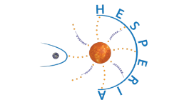The STEREO REleASE notification system
The STEREO Relativistic Electron Alert System for Exploration (STEREO REleASE) makes use of relativistic electrons provided by the Solar Electron Proton Telescope (SEPT; in the energy range of 0.125 - 0.255 MeV) and the High Energy Telescope (HET; in the energy range of 0.7 - 4.0 MeV) aboard the Solar TErrestrial RElations Observatory (STEREO), providing deterministic forecasts of the expected proton flux at the energy range of 20.8 - 40.5 MeV.
A needle gauge indicates in real-time and in a user-friendly mode the expected radiation impact labelled according to the following three discrete levels:
─ Quiet l Green color
─ Warning l Orange color
─ Alert l Red Color
Combined forecast conditions from both SEPT and HET instruments, as defined in the accompanying table below, are used to determine the gauge status. Below the gauge we indicate if there is presently an on-going significant solar proton event (SEP) or not, as well as the temporal validity of the present gauge state. The duration of an on-going SEP event is defined as the time interval between the proton event occurrence (when the real-time HET proton flux first surpasses the set 0.22 cm-2 s-1 sr-1 MeV-1 threshold) and the time that the one-hour averaged HET proton flux drops below 0.044 cm-2 s-1 sr-1 MeV-1. The temporal validity for the Quiet state is set at 20 min (ends if a Warning or Alert occurs), for the Warning state at the resolution of the STEREO measurements until a new state is produced, and for the Alert state at 20 hours (if no-SEP occurs) or until the end of an SEP (as defined above) that occurred within the initially set 20-hour interval.
The STEREO REleASE Alert System can generate alerts which are distributed to registered users. You can register here.
Validation
Historic (not real-time) data of STEREO/SEPT & HET from 2008 to mid-2022 were used to find a good forecast condition for SEP event and to quantify the event-oriented validation metrics (POD, FAR and advanced warning time). Two proton flux threshold values were evaluated 0.1 and 0.22 cm-2 s-1 sr-1 MeV-1 for SEP events, resulting in 49 and 38 events, respectively, during the analysed period. To make sure that the event getting evaluated is not part of the training data of the used forecasting matrices, a Python script was developed that removed the event from the dataset, recreated the matrices with the reduced dataset and afterwards used these on the excluded event. Validation has been performed on SEPT and HEP forecasts, both separately and combined, with the Alert occurring as defined in the Table above. The advanced warning time (AWT), defined as the time between the first warning of the system and when the actual observed proton flux crossed the defined threshold, has been also evaluated.
Validation indicates that STEREO REleASE better performs for the 0.22 cm-2 s-1 sr-1 MeV-1 event threshold value and for the combined SEPT and HET forecasts.
Table 1. Results of the STEREO/REleASE validation
| Validation for the cm-2 s-1 sr-1 MeV-1 SEP threshold value (49 SEPs) | ||||
|---|---|---|---|---|
| POD | FAR | Mean AWT | Median AWT | |
| HET | 73% | 25% | 177 min | 58 min |
| SEPT | 65% | 58% | 111 min | 46 min |
| Combined | 76% | 31% | 183 min | 53 min |
| Validation for the 0.22 cm-2 s-1 sr-1 MeV-1 SEP threshold value (38 SEPs) | ||||
| POD | FAR | Mean AWT | Median AWT | |
| HET | 76% | 19% | 258 min | 60 min |
| SEPT | 81% | 46% | 127 min | 47 min |
| Combined | 87% | 25% | 233 min | 54 min |

 hesperia [dot] info [at] hesperia-space [dot] eu
hesperia [dot] info [at] hesperia-space [dot] eu


